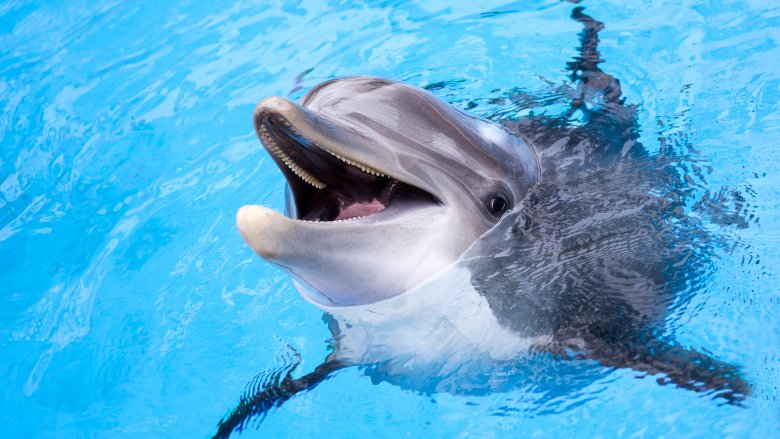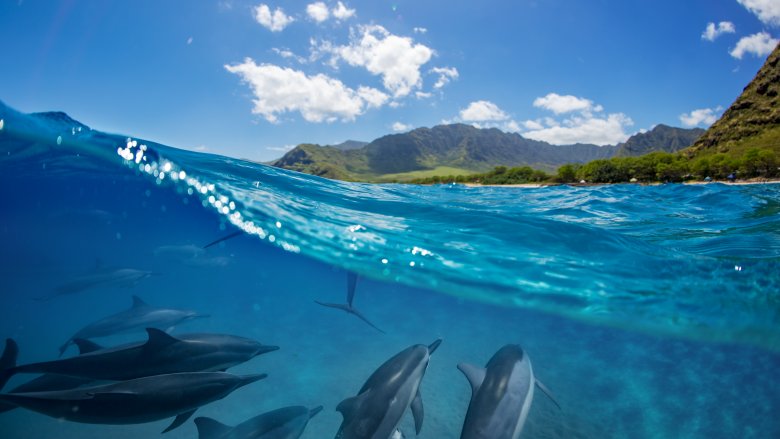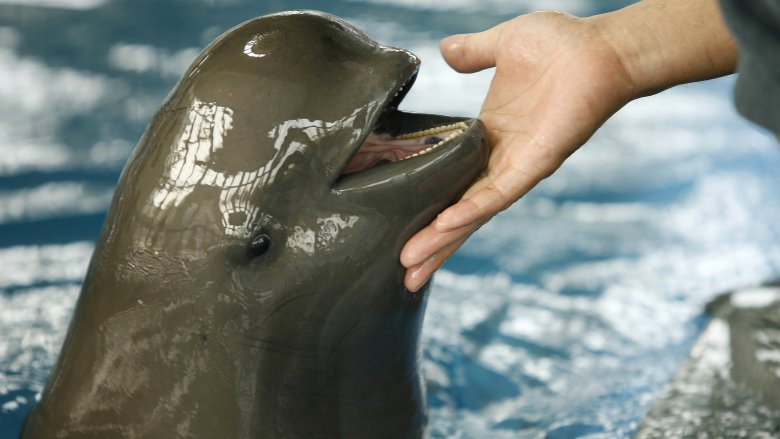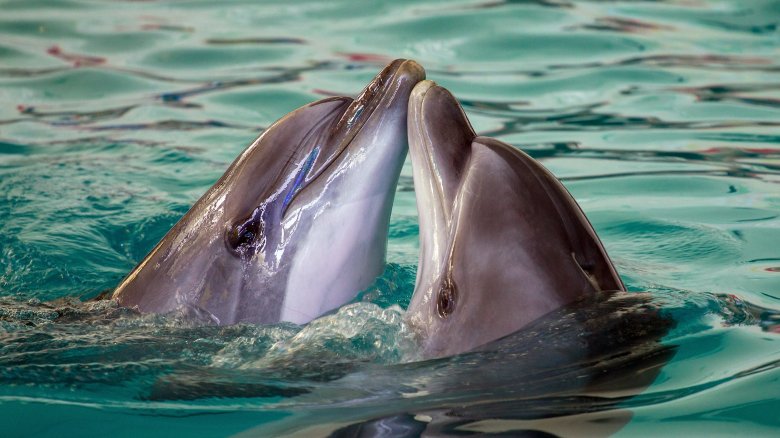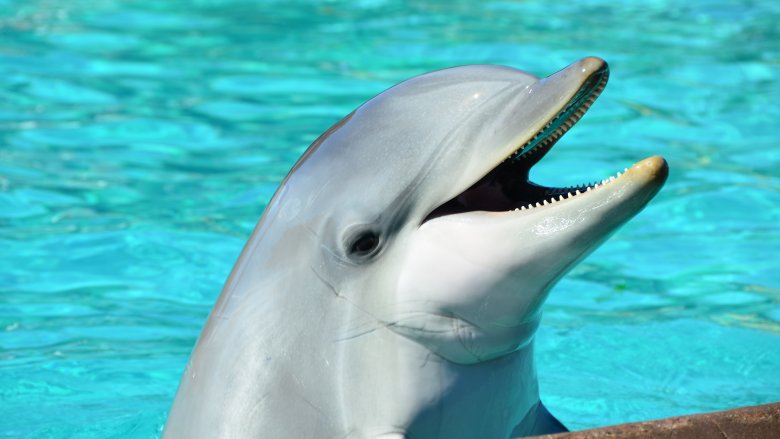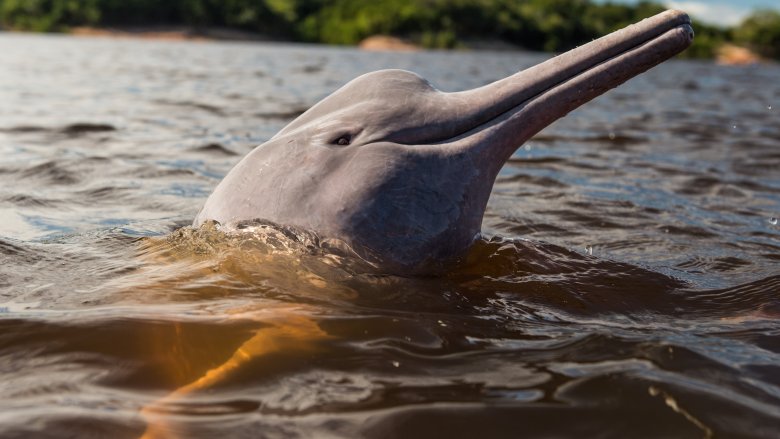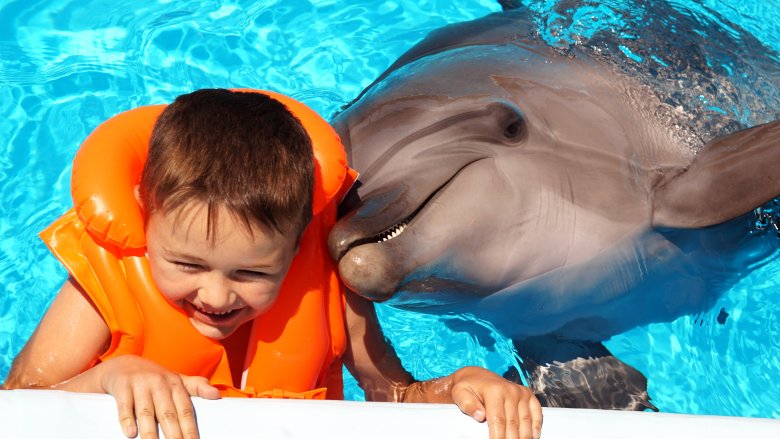False Facts About Dolphins You Always Thought Were True
It's just a fact: if you don't love dolphins, you have no soul. They're beautiful, they're graceful, they've got a heaping helping of personality ... that's ignoring their aggression and sexual deviance, but hey, no one's perfect. They're so popular, it's not surprising that we think we know more about them than we actual do. Scientists are still divided about reported aggression from dolphins, but there are plenty of dolphin myths we've definitely debunked.
Dolphins have the best sense of hearing
It's hard to imagine experiencing the world through the eyes and ears of another creature. (But we'd love to see some YouTube interpretations, and you can have that idea for free.) There's a rumor that dolphins have the best hearing in the world, but according to the Dolphin Communication Project, dolphins aren't even close to the best. To put things in perspective, according to Popular Science, humans can hear sounds up to a frequency of about 20 kHz. That makes dolphin ears way more impressive than ours, as they can hear to about 160 kHz. But researchers from the University of Strathclyde in Scotland have found a lowly little moth can hear up to 300 kHz. You can't even begin to imagine what the world sounds like to that moth.
There's another weird thing you should know about a dolphin's sense of hearing — a lot of them can't hear anything at all. One study at the University of South Florida on mass dolphin strandings found that about half the bottlenose dolphins that strand themselves seemed to be completely deaf. Scientists don't know what causes this high rate of deafness in dolphins or how widespread the problem is, but either way, popular belief fails again.
Dolphins have a language just like people do
Listen to dolphins chattering away, and it's easy to assume they're speaking a language a lot like ours. But it's not that straightforward, and we need to clear something up first. Scientists define language in a couple different ways. One is a metaphorical language — it's how we can all appreciate Beethoven — and another is a simply a communication system. We could argue that dolphins can communicate with each other, but so can cats, horses, and sorority girls. To get to the heart of what defines language, you have to go a bit deeper. There's innate skill, a complex set of rules for pronunciation, syntax, semantics, and sarcasm ... we'll just say it's a lot more complicated than Tri Delta's thrilled squeals.
To say that dolphins speak a language implies they're making noises that are actual words and sentences with definite construction and laws. There's plenty of evidence that suggests they communicate, but evidence of actual structured language has yet to be found. When Russian scientists claimed to have proof of dolphin language in 2016, other marine experts pushed back, stating there are too many unknowns to draw that conclusion yet. In the meantime, dolphins will have to be happy with just communicating, and there's nothing wrong with that. We love them anyway.
'Dolphin' and 'porpoise' are interchangeable terms
Contrary to what you were told by that nerdy kid in fourth grade, "porpoise" isn't just a smarter, fancier way of saying "dolphin." The National Ocean Service gives a great run-down on the differences between these two animals, and it's surprisingly easy to see once you know what you're looking for. (Like in the above picture of a porpoise.)
Dolphins have a long, beak-like mouth (like you see in bottlenose dolphins), while porpoises have a flatter face and a smaller mouth. You might not get close enough to see (and you really shouldn't), but dolphins also have pointed teeth as opposed to the flat teeth of a porpoise. Dolphins are the talkative ones — porpoises are mostly silent, like the introverted friend at the party — and dolphins are generally leaner and sleeker. Porpoises, on the other hand, tend to look like they've eaten a few too many pizzas and are currently regretting their life choices. There are only six species of porpoises and 32 species of dolphins, and an easy way to remember which is which is to think of the dolphin as the frat boy with a lot to say and the porpoise as the slightly tubby, quiet little freshman in the room.
Dolphins are the only other species that has sex for pleasure
Part of the reason dolphins are so awesome is they're said to be the only non-human species that has sex for pleasure. That's a lofty claim to make, if you think about it. (We couldn't find any studies that asked personal questions about other animals' bed-wrestling motivations.)
We only know by observation, and there's a lot of research (almost an unsettling amount?) that's been done on whether other species seek out experiences that feel pleasurable. According to the BBC, rats "laugh" and enjoy being tickled. Bonobos hook up in same-sex couples for pretty passionate encounters that are clearly not driven by the need to reproduce, and female lions go through a fertile week where they mate up to 100 times a day. We're going out on a limb to suggest that's probably not completely necessary, but it does indicate that regardless of how dolphins decide to spend their private time, they're not the only ones who participate in certain behaviors just to feel good.
Dolphins smile because they're happy animals
Bottlenose dolphins always look so happy, don't they? Well, buckle up and hang onto your childhood.
Ric O'Barry is the dolphin expert who trained the dolphins that would portray Flipper, which is all the street cred he needs. You might recognize the trainer-turned-activist from the documentary The Cove, and he's also written a book called Behind the Dolphin Smile. He calls the dolphin's charismatic smile "nature's greatest deception," telling People: "It creates the illusion that they're always happy. I think this multibillion-dollar captivity industry is built on that optical illusion."
Dolphin Communication Project research associate Justin Gregg agrees, writing, "Oh, you mean the smile that [...] is permanently frozen in place because dolphins can't change their facial expressions?" Smiling is a human interpretation of happiness, but when it comes to dolphins, it's not the least bit accurate. That's not emotion, that's just how their faces look. Like clowns. No one believes a painted clown face truly signals happiness, so don't believe that captive dolphin is happy, either.
Dolphins live in established family groups
You've probably heard that dolphins live in family groups called pods, but that's an oversimplification we probably picked up in kindergarten. The truth is much cooler. The Dolphins of Shark Bay Research Project has been studying every aspect of bottlenose dolphin life for decades and has found that instead of traveling with the same herd 24/7, bottlenose dolphins have what they call "a continuous overlapping mosaic of relationships." Strong bonds exist between mothers and children and between male BFFs, but otherwise, they meet up, chat a bit, and move on — kind of like humans network.
The Whale and Dolphin Conservation Society spent 12 years tracking dolphin movements off the coast of Scotland, and they discovered the benefits of the dolphins' flexible social structure. Group members would break off to hunt, and once schools of fish were found, individual dolphins would head out to smaller groups to spread the word about where they could get a good meal. Instead of thinking of dolphins as traveling in devoted family groups like wolves might, think of them as having their own LinkedIn network.
Dolphins all live in the ocean
Most of the dolphins we see and hear about live in ocean environments, so it's easy to assume that all dolphins are found in the ocean. But it just isn't the case.
According to the Marine Mammal Commission, there are several species of freshwater dolphins (like the pink river dolphin shown above) fighting for survival in Asia and South America. One species — the Yangtze River dolphin — went extinct fairly recently, and others are threatened. The Smithsonian says the Indus River dolphin is heading in the same direction thanks to a series of Pakistani dams that fragmented its natural habitat. Their increasing rarity is one reason we tend to overlook them, and numbers are dwindling mostly due to human activity. In the Amazon, river dolphins are even being killed and used as bait by local fishermen. Seriously. You can only wish we were making that up. Factor in pollution, noise, dangerous boats, overfishing, disappearance of food sources, and rivers that are being drained by irrigation, and there might come a time when this myth becomes truth. Let's make sure we don't have to say "so long, and thanks for all the fish." Using an endangered animal for bait is pretty horrible, even for humans.
The U.S. military trained dolphin assassins
After Hurricane Katrina, a story about escaped dolphin assassins started circulating. It was one of those stories that had just enough credibility to make it seem possible, but this is another myth.
Credibility for this came from the fact the U.S. military has been upfront about its investigation into the possibility of using dolphins for military purposes. Gizmodo says official projects started in the 1960s and that dolphins were used throughout the Vietnam War to scout for underwater bombs and mines. They've regularly been employed as military scouts, but come on ... not the same thing. During the Cold War, there were rumors of a Russian project that was looking into training killer dolphins, but just how far it went isn't clear.
According to an interview with Marine Life Oceanarium president Moby Solangi, the whole thing is made even more ridiculous by claims that dolphins are being trained to fire poison darts at their targets. We know it's not true, for one simple reason: no opposable thumbs. Case closed.
Dolphins are an amazing therapy animal
There's no denying that giving your dog or cat a big old hug when you get home after a hard day makes you feel better. But dolphins? According to some, they're the latest and greatest therapy animal. If you need a pick-me-up, you can try out a dolphin-assisted therapy program, and you can even have one assist you in childbirth.
Whale and Dolphin Conservation says there's no evidence swimming with a dolphin is going to have the same kind of benefits as seeing a human therapist. They're also calling for a ban on the whole thing. In spite of a belief that swimming with dolphins is an awesome treatment for psychological and physical conditions from MS to autism, it could do more harm than good. It could hurt, quite literally, and this is where we remind you that in their hearts, dolphins are still wild animals: relatively large, very powerful wild animals. And there are no regulations governing dolphin therapy, so if you pick even the most reputable-looking New Age place you can find online, you could still be hopping in the water with a dolphin that has no medical training of its own.
As for the supposed benefits of dolphin-assisted births, there's no proof that babies born in the water with dolphins develop faster than others or that newborn babies love a swim alongside some dolphins. And your kid sure won't be able to speak dolphin. Stop it.
Dolphins can only breathe through their blowhole
You aren't crazy — dolphins breathe through their blowhole most of the time. It's essentially a nostril on the top of the dolphin's head, and it works really well. They have lungs just like we do, and for a long time, scientists thought that the only way a dolphin could breathe was by using the blowhole.
But, to quote a wise man, "Science is a liar sometimes." In 2014, dolphin researchers and conservationists from the University of Otago in New Zealand found a Hector's dolphin that had learned to breathe through its mouth. Not only does it have to surface more completely than its companions, but it had to learn to move its larynx and essentially re-teach vital biological systems how to communicate with each other. Dolphins have also been seen blowing bubbles with their mouths, so while they don't do it often, they can learn this pretty mind-blowing adaptation. The mouth-breathing dolphin's ability was likely developed out of necessity, possibly because of an injury that made traditional breathing impossible. That's a survivor! It'd be like learning to breathe through your eyeballs.
